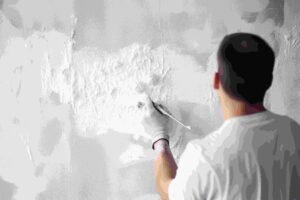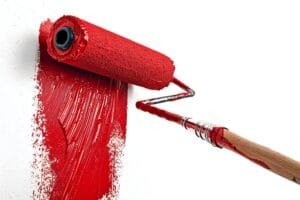Introduction to Exterior Paint
Choosing the right exterior paint is pivotal for both the aesthetic appeal and the structural integrity of a building. Unlike interior paints, exterior paints are formulated to withstand harsh weather conditions, ranging from intense sunlight to heavy rainfall and fluctuating temperatures. This added durability is essential in preventing long-term damage and ensuring that the building remains protected over time.
One of the primary distinctions between exterior and interior paints lies in their composition. Exterior paints are designed with robust binders and pigments that offer enhanced resistance to fading and peeling. These paints often contain additives to combat mildew growth and UV radiation, providing a fortified barrier against external factors. This differentiation is critical, as buildings are consistently exposed to elements that can erode and deteriorate standard paints.
Furthermore, exterior paints are engineered to be more flexible than their interior counterparts. This flexibility helps accommodate the expansion and contraction of building materials due to temperature changes. As a result, exterior paints contribute significantly to maintaining the building’s structural stability.
The choice of exterior paint also influences the building’s energy efficiency. Certain types of exterior paints can reflect a higher percentage of sunlight, thereby reducing heat absorption and lowering cooling costs during warmer months. Hence, selecting the appropriate paint not only enhances visual appeal but also provides practical benefits such as improved energy efficiency and extended longevity of the building surfaces.
In conclusion, understanding the vital elements that differentiate exterior paint from interior variants is essential for making a well-informed choice. Prioritizing factors such as durability, weather resistance, and flexibility ensures that the paint not only beautifies the exterior but also offers a robust shield against environmental wear and tear.

Types of Exterior Paint
When selecting exterior paint, understanding the four primary types can significantly aid in making an informed decision. Each category offers unique properties tailored to specific needs and environments. This section provides an in-depth look at latex, oil-based, acrylic, and elastomeric paints to guide you through their advantages and disadvantages.
Latex Paint is a popular choice due to its flexibility and ease of use. Latex paint, composed of water and synthetic resins, dries quickly and offers minimal clean-up hassle. It also emits fewer volatile organic compounds (VOCs), making it environmentally friendly. However, its suitability is limited to less humid climates as it tends to peel or chip off in extremely moist conditions.
Oil-Based Paint boasts superior durability and a glossy finish, ideal for high-traffic areas. Made from natural or synthetic oil, this paint type provides robust adhesion and protection against extreme weather conditions. The downside includes longer drying times and higher VOC emissions, necessitating proper ventilation during application. Cleaning tools post-application is also more labor-intensive, requiring mineral spirits or turpentine.
Acrylic Paint, closely related to latex, is another versatile option. This paint combines the benefits of water-based composition with enhanced durability. Acrylic paint resists chipping and fading better than standard latex, making it suitable for diverse climates. Its ease of application and water clean-up advantage it over oil-based alternatives. Yet, it might not provide the same high-gloss finish sought by some homeowners.
Elastomeric Paint stands out for its elastic properties, making it the best choice for surfaces prone to cracking. This type of paint expands and contracts with the substrate, preventing cracks from becoming problematic. It’s particularly advantageous for masonry and concrete surfaces. However, elastomeric paint is thicker and can be challenging to apply without professional tools or expertise.
Considering these paint characteristics helps in selecting the most appropriate type for your exterior surfaces, ensuring longevity and aesthetic appeal tailored to your specific requirements and environmental conditions.

Factors to Consider When Choosing Exterior Paint
When it comes to choosing exterior paint, several critical factors must be considered to ensure the durability and aesthetic appeal of your home’s exterior. One of the foremost considerations is the climate of your region. Different paints are formulated to withstand varying weather conditions, whether it’s scorching heat, high humidity, or freezing temperatures. For instance, latex-based paints are excellent for their flexibility and breathability, making them ideal for regions with extreme temperature variations.
The surface material of your exterior also plays a significant role in paint selection. Wood, brick, stucco, and metal each have unique characteristics that can affect paint adhesion and longevity. For example, masonry surfaces often require a paint that is highly breathable and resistant to alkali. Conversely, wooden exteriors benefit from paints with superior expansion and contraction properties to mitigate cracking and peeling.
Eco-friendliness is becoming an increasingly important factor for many homeowners. Eco-friendly paints, typically low in volatile organic compounds (VOCs), contribute to a healthier environment and reduce the impact on indoor air quality. These paints are specially formulated to minimize the release of harmful chemicals, making them a wise choice for families and environmentally conscious individuals.
Another critical factor is color retention. Exterior paints that offer excellent UV resistance and fade protection will help maintain the vibrant appearance of your home for a longer period. Investing in high-quality paints known for their color retention properties ensures that your home remains aesthetically pleasing over time.
Finally, the reputation of the paint brand should not be overlooked. Established brands often have a proven track record of performance and durability, backed by extensive research and development. Opting for a reputable brand can provide peace of mind, knowing that the products have been tried and tested, and often come with warranties for added assurance.
Preparing Your Exterior for Painting
Achieving a durable and aesthetically pleasing exterior paint job starts with meticulous preparation. Proper preparation ensures that the paint adheres well to the surfaces, thereby enhancing longevity and appearance. The first step in this process is thorough cleaning. Removing dirt, mildew, and old paint is vital. A pressure washer is particularly effective for this purpose, albeit one should exercise caution to avoid damaging the surface with high pressure.
Once the exterior is clean, the next step involves repairing any damage. This includes filling in cracks, patching holes, and replacing any deteriorated wood or siding. Neglecting this step can lead to uneven paint application and potentially compromise the structure’s integrity. For filling smaller imperfections, use an exterior-grade filler; for larger repairs, you may need to employ more substantial materials like epoxy or new sections of siding.
Sanding is the third crucial stage in surface preparation. By sanding the surfaces, you ensure a smooth and even texture, which helps the new paint adhere better. Use medium-grit sandpaper for this task. Pay special attention to edges and corners, as paint tends to peel faster in these areas. After sanding, always clean the surfaces again to remove any dust or debris that might interfere with paint adhesion.
Priming is an often-overlooked but essential part of exterior painting. A primer coat serves multiple purposes: it seals the surface, provides a uniform base for the paint, and can also mask any lingering stains or color variations. Choosing the right primer depends on your surface material – whether it’s wood, metal, or masonry. Water-based primers are generally suitable for most surfaces, but oil-based primers provide extra durability, especially for wood surfaces.
Equipping yourself with the right tools further enhances the effectiveness of these preparation steps. High-quality brushes, rollers, and sprayers can make a significant difference in achieving a flawless finish. Don’t forget to wear appropriate protective gear like gloves, goggles, and masks to ensure your safety throughout the preparation process. Investing time and effort in surface preparation will undoubtedly pay off, leading to a more resilient and visually pleasing exterior paint job.

Application Techniques for Exterior Paint
Successfully transforming your home’s exterior with a fresh coat of paint requires mastering various application techniques. Whether you opt to brush, roll, or spray, each method comes with its respective steps and best practices to ensure a smooth, even finish.
Brushing
Brushing is a traditional technique ideal for intricate areas and detailed work. To begin, use high-quality brushes specifically designed for exterior paint. Start by thoroughly mixing the paint to ensure uniformity. Dip the brush into the paint, loading it just enough to cover the bristles halfway. Apply the paint in tight, smooth strokes, moving in one direction to avoid lap marks. For best results, use angular sash brushes for cutting in edges and trimming details, while wider brushes can cover larger, flat surfaces efficiently.

Rolling
Rolling is suitable for expansive, flat surfaces and can significantly reduce project time. Select a long-handled roller with a thick nap cover designed for rough exterior textures. Begin by saturating the roller cover in paint, allowing excess to drip off. Work in sections, applying the paint in a ‘W’ or ‘M’ pattern before filling in the gaps. This technique ensures even distribution and prevents streaking or patchiness. Apply moderate pressure to avoid splattering and achieve consistent coverage. It’s advisable to use a paint tray to regulate the amount of paint on the roller.

Spraying
Spraying is the quickest method, offering a flawless finish when performed correctly. Utilize an airless paint sprayer for best results and practice on a spare piece of material before proceeding. Thin the paint as necessary, depending on the sprayer’s specifications. Maintain a consistent distance from the surface, typically around 12 inches, and move the sprayer in controlled, overlapping strokes to prevent runs and ensure even coverage. Mask off areas not intended for painting to avoid overspray.
Regardless of the chosen technique, avoid common pitfalls such as painting under direct sunlight or during inclement weather, which can affect the drying process and final appearance. Proper surface preparation—cleaning, sanding, and priming—cannot be overstated, as it foundationally supports the paint’s adhesion and longevity. By adhering to these application techniques and best practices, you can achieve a professional and lasting exterior paint job.

Choosing the Right Color and Finish
When it comes to selecting the ideal exterior paint for your home, the choices can often seem overwhelming. The first step in making the right decision is considering the architectural style of your home. Traditional homes might benefit from a classic color palette that respects historical roots, like earth tones or muted shades. Modern homes, on the other hand, may look striking in bold, vibrant colors that reflect contemporary aesthetics.
The surrounding environment also significantly influences color selection. Homes situated in lush, green areas often look harmonious when painted in shades that complement the natural landscape, such as greens, beiges, or even natural wood stains. In contrast, coastal homes might take advantage of lighter, airy colors like pastels to blend seamlessly with their surroundings.
Once you’ve decided on a color that fits the architectural style and setting, understanding different finishes is equally crucial. Exterior paints come in various finishes, each with distinct characteristics and best-use scenarios. A matte finish offers a non-reflective surface that helps cover imperfections but may not be as durable under harsh weather conditions. It’s ideal for older homes with blemishes on their exterior surfaces.
Satin finishes offer a slight sheen and are more durable than matte, making them versatile for a range of exterior surfaces. This finish provides a balance between durability and aesthetic appeal and works well for areas like wood siding, trim, and shutters. A gloss finish, on the other hand, offers the most durability and a high level of shine, making it perfect for doors, metal features, and areas requiring frequent cleaning.
Ultimately, choosing the right color and finish is about finding the balance between aesthetic appeal, functional requirements, and the architectural essence of your home. Considering all these factors will ensure that your home not only looks stunning but also stands resilient against the elements.
Maintaining Your Exterior Paint
Proper maintenance is crucial for extending the life of your exterior paint, ensuring that your home remains aesthetically pleasing and protected from the elements. Routine maintenance tasks include regular cleaning, addressing minor touch-ups, and thorough inspections. Implementing these tasks can significantly enhance the durability and longevity of your exterior paint.
Start with a regular cleaning schedule for your exterior walls to remove dirt, mildew, and other debris that can accumulate over time. Using a soft-bristle brush and a mild detergent, gently scrub the exterior surfaces, followed by rinsing with a garden hose. Avoid using high-pressure washers as they can strip the paint and damage the surface underneath.
Touch-ups are an essential part of maintaining your exterior paint. Annually inspecting your home’s exterior for small chips, cracks, or areas where the paint has worn away can prevent more significant issues down the line. Keep a small amount of leftover paint from the initial application for these minor repairs. When touching up, ensure the surface is clean and dry before applying a new coat of paint to blend seamlessly with the existing color.
Regular inspections of the exterior paint are vital, ideally conducted twice a year, in spring and fall. During these inspections, look for signs of peeling, cracking, or fading. Peeling paint indicates that the underlying surface isn’t adequately protected and may need more extensive repair work. Address peeling by scraping off the old paint, sanding the area, and applying a primer before repainting. Cracking often results from fluctuating temperatures and can be managed similarly by removing the damaged paint and preparing the surface for a new coat.
Fading is another common issue, particularly with houses exposed to excessive sunlight. Using high-quality, UV-resistant paints during the initial application can mitigate this problem. If fading has already occurred, consider repainting the affected areas with a fresh coat of paint and a protective finish designed to withstand UV rays.
By implementing these maintenance practices, you ensure that your exterior paint remains vibrant and protective for years to come. Regular cleaning, touch-ups, and inspections are essential steps in preserving the integrity and aesthetic appeal of your home’s exterior.
Hiring Professionals vs. DIY
Selecting the appropriate avenue for your exterior painting project is a critical decision that hinges on various factors, including costs, time, and skill level. Weighing the pros and cons of hiring professionals versus undertaking a do-it-yourself (DIY) endeavor can help you make an informed choice.
One of the primary advantages of hiring professional painters is the expertise and quality they bring to the project. Professionals are adept at surface preparation, application techniques, and ensuring an even finish that is likely to last longer. They are also equipped with high-grade tools and materials that may not be accessible to the average homeowner. Additionally, professionals are typically insured, which provides a layer of protection in case of any accidents or damages during the project.
However, hiring professionals can be costly. Labor charges, materials, and potential additional fees can significantly increase the overall expense. It is essential to obtain multiple quotes and check reviews to ensure you are choosing a reputable service provider. Ensuring the contractor is licensed and has good references can save you from future troubles.
On the other hand, undertaking the painting project as a DIY endeavor can be cost-effective if you possess the necessary skills and tools. DIY painting allows for budget flexibility as you control the type and quantity of materials used. It also provides a sense of accomplishment and the freedom to work at your own pace. Nevertheless, the time investment required for a DIY project can be considerable. Surface preparation, choosing the right kind of paint, and the actual application can be time-consuming tasks. Additionally, the lack of professional skills might result in an uneven finish or issues with the paint adhering properly.
If you choose the DIY route, it’s crucial to conduct thorough research and possibly even consult with a professional for initial guidance. Budgeting for high-quality materials and allocating appropriate time can go a long way in ensuring a successful project.
Ultimately, the decision between hiring professionals and opting for a DIY approach boils down to your budget, available time, and comfort level with painting skills. Both options have their own sets of benefits and drawbacks, and understanding these can help you choose the best path for your exterior painting project.
